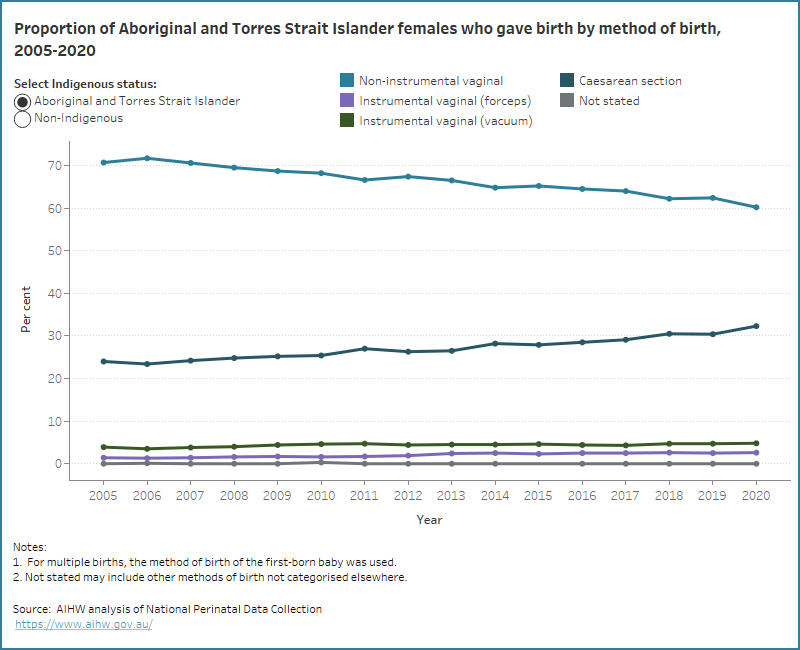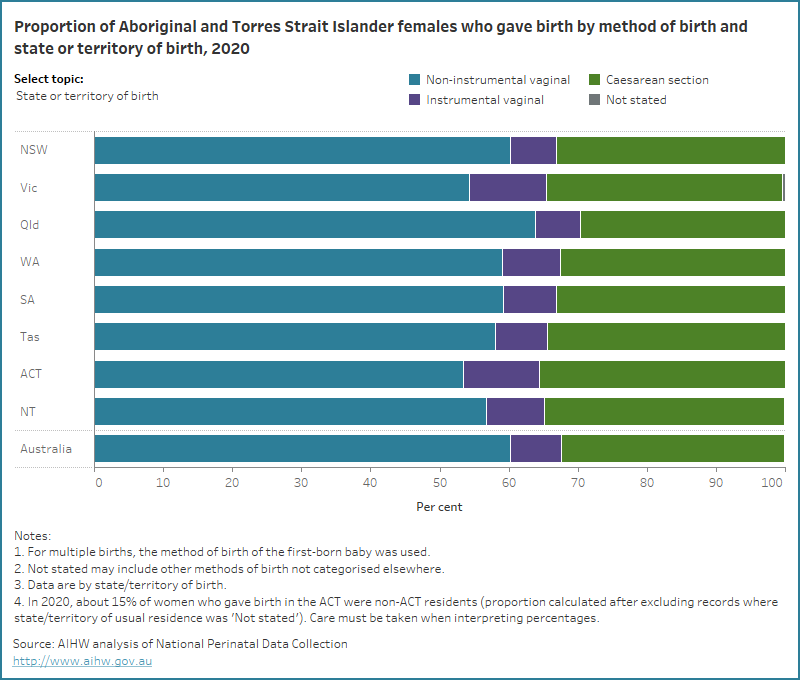 Method of birth
Method of birth
Method of birth refers to how the baby was born, which may be vaginally – non-instrumental or with the assistance of forceps or vacuum (instrumental vaginal birth) – or by caesarean section.
Each method of birth is chosen by women and their healthcare providers to minimise complications and increase the likelihood of positive pregnancy outcomes (AIHW 2022). Non-instrumental vaginal births are associated with lower risk of maternal complications, such as infection and haemorrhage, when compared with instrumental vaginal and caesarean section birth (ACSQHC 2018; Victorian Department of Health 2017; RANZCOG 2020).
In 2020, 60% of Aboriginal and Torres Strait Islander females who gave birth had a non-instrumental vaginal birth, 2.6% had an instrumental birth assisted by forceps, 4.8% had an instrumental birth assisted by vacuum and 32% had a caesarean section birth (compared with 50%, 5.4%, 7.6% and 38% of non-Indigenous females).
Over time, the proportion of Aboriginal and Torres Strait Islander mothers who had a non-instrumental vaginal birth has decreased (from 71% in 2005 and 72% in 2006 to 60% in 2020), whilst there has been a corresponding increase in the proportion who had an instrumental vaginal birth assisted by forceps (from 1.4% in 2005 to 2.6% on 2020) or vacuum (3.9% to 4.8%) and caesarean section birth (from 24% in in 2005 to 32% in 2020).
Having had a previous caesarean section can be associated with an increased risk of adverse outcomes for women and their babies during subsequent pregnancies, most often due to uterine scarring (Chauhan et al. 2003; Jamshed et al. 2022).
Many women who choose to give birth vaginally after having had a previous caesarean section are successful (RANZCOG 2022). In 2020, 18% of Aboriginal and Torres Strait Islander females who had previously given birth by caesarean section had a vaginal birth (compared with 14% of non-Indigenous females).
The data visualisation below shows the proportion of Aboriginal and Torres Strait Islander and non-Indigenous females who gave birth by method of birth, from 2005.
Figure 1: Proportion of Aboriginal and Torres Strait Islander and non-Indigenous females who gave birth by method of birth from 2005 to 2020
Line graph of method of birth by Indigenous status. Aboriginal and Torres Strait Islander mothers with caesarean section birth increased.

Greater proportions of Aboriginal and Torres Strait Islander mothers had a non-instrumental birth if they:
- were aged under 20 years or 20-24 years (both 63%, compared with 49% of those 40 years and over)
- had a parity of 4 or more (69%, compared with 51% of first-time mothers)
- had spontaneous labour (79%, compared with 69% for induced labour)
- gave birth in a public hospital (59%, compared with 51% for private hospitals).
Instrumental vaginal birth was more common for Aboriginal and Torres Strait Islander mothers who lived in the least disadvantaged areas (12%), were aged under 20 years (13%), were first-time mothers (17%) or had induced labour (11%).
The proportion of Aboriginal and Torres Strait Islander mothers who had a caesarean section birth was higher for those who were aged 40 years and over (46%) or gave birth in a private hospital (38%).
The data visualisation below presents data on method of birth for Aboriginal and Torres Strait Islander females who gave birth, by selected maternal characteristics for 2020.
Figure 2: Proportion of Aboriginal and Torres Strait Islander females who gave birth by method of birth and selected topic for 2020
Bar chart for method of birth by selected topics. 60% of Aboriginal and Torres Strait Islander mothers had non-instrumental vaginal birth.

Aboriginal and Torres Strait Islander mothers who lived in some geographical locations were more likely to have a caesarean section birth. Explore the map below to view data on the number and proportion of Aboriginal and Torres Strait Islander mothers who had a caesarean section birth, by IREG and PHN for 2020 and SA3 for 2017-2020.
Figure 3: Proportion of Aboriginal and Torres Strait Islander females who gave birth and had a caesarean section birth by various geographies
Map of proportions of Aboriginal and Torres Strait Islander mothers who had a caesarean section birth across Australia grouped by various geographies.
ACSQHC (Australian Commission on Safety and Quality in Health Care) (2018) The second Australian atlas of healthcare variation, ACSQHC, accessed 18 October 2022.
AIHW (Australian Institute of Health and Welfare) (2022) Australia’s mothers and babies, Cat. no. PER 101. Canberra: AIHW.
Chauhan SP, Martin JN Jr, Henrichs CE, Morrison JC and Magann EF (2003) ‘Maternal and perinatal complications with uterine rupture in 142,075 patients who attempted vaginal birth after cesarean delivery: a review of the literature’, American Journal of Obstetrics Gynecology, 189(2):408–417, doi:10.1067/s0002-9378(03)00675-6.
Jamshed S, Chien SC, Tanweer A, Asdary RN, Hardhantyo M, Greenfield D, Chien CH, Weng SF, Jian WS and Iqbal U (2022) ‘Correlation between previous caesarean section and adverse maternal outcomes accordingly with Robson classification: systematic review and meta-analysis’, Frontiers in Medicine, 10(8):740000, doi:10.3389/fmed.2021.740000.
RANZCOG (Royal Australian and New Zealand College of Obstetricians and Gynaecologists) (2020) Instrumental vaginal birth RANZCOG, accessed 18 October 2022.
RANZCOG (2022) Birth after previous caesarean section, RANZCOG, accessed 18 October 2022.
Victorian Department of Health (2017) Caesarean section, Victorian Department of Health, Victorian Government, accessed 18 October 2022.


